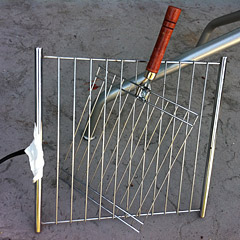Posted: April 22nd, 2015 | Author: Nathan | Filed under: field recording, gear, nature recording, sound design
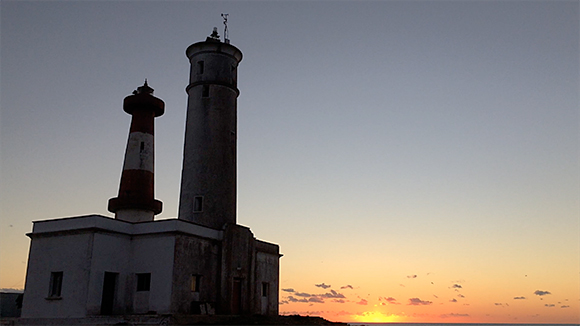
My past winter holiday involved a sea kayak crossing to Las Islas de Los Todos Santos, a pair of islands four nautical miles offshore of Ensenada, México. We were greeted – and partied with – a nearly toothless lighthouse keeper, and slept in an old lighthouse built in the 1930’s.
We had two days of 15-25 knot winds, and as you might imagine, a lighthouse is a roughshod place. The winds were howling through the old windows and making amazing sounds.
Only one problem: I had a small sea kayak with no room to even pack a handheld field recorder. As I’ve said many times before, the best field recorder is the one you have with you, and this case, my only option was my iPhone. In glorious, shimmering mono.
Today’s sound are of these howling winds, recorded with the Voice Memos app on iOS. I’m not about to make a habit of using my iPhone as a field recorder, even with aftermarket microphones, but hopefully this goes to show that sometimes you do the best with what you have. Especially if the sounds and location are literally once-in-a-lifetime events.
[soundcloud url=”https://api.soundcloud.com/tracks/200338437″ params=”color=ff5500&auto_play=false&hide_related=false&show_comments=true&show_user=true&show_reposts=false” width=”100%” height=”166″ iframe=”true” /]
Tags: ambience, creepy, resonance, sound design, sound effects, wind | No Comments »
Posted: March 25th, 2014 | Author: Nathan | Filed under: music, video/motion
We all get caught between having creative ideas, yet having extremely limited available time to explore them. To explore some personal creative ideas during an extremely busy time, I decided to give myself a challenge: Create a shortform video in 36 hours, inclusive of shooting, post, and sound.
It wouldn’t be the best thing ever, but it’d be a Thing. A Thing would be done…or as done as I could make it. The goal wasn’t to create the best thing ever…it was to make something. Period. And the time constraint would force concision, hard choices, and provide the constraints needed to be creative.
This resulted in The Barn. If you’d like to watch this short video, I’d prefer you watch this full screen. I’ll wait right here.
Given the focus of this blog, I suppose that I should speak to the music in a little more detail. I conceived, shot, and did a rough edit of the video in about a day. I slept on it, and composed the music the following morning in one session. The soundtrack is influenced by what I’ve been listening to recently: Ben Frost, Kammarheit, Erik Skodvin, Elegi, Stefan Németh, Paul Corley, and others. The music started with a sampler patch I created based on me playing my guitar with a cello bow, and some guitar plucks prepared with small magnets. Samples included wood floor creaks and static bursts that I had recorded or generated over the past year. It was created in Logic Pro 9. (The description on Vimeo addresses more about visuals for those that are interested.)
Could the music be better? More dynamic? More varied? Sure, yes, on all fronts, with no doubt. But this was an exercise in reaching done, a battle against hoping to maybe-sorta start something, and actually making something, warts and all. As they say, “Better can be the enemy of done.”
There are a bajillion things I’d like to change, improve, and alter. But in 36 hours – including decent sleep – that’s not important. The goal was to express an idea with time as the primary constraint. And the goal isn’t to continue to obsess and tweak this project: It’s done. Now it’s time for the next Thing.
I learned a lot from this small project, and will definitely do more 36-hour projects in the future. I relish constraints, even if they are arbitrary: They focus the mind like nothing else, and soothe the Blank Canvas Problem.
I welcome any thoughts, especially on the value of constraints, in the comments below. Thanks for watching and listening. I’ll return to more typical posts on field design and sound recording in the coming weeks.
Tags: composition, creativity, creepy, music 2014, video | 5 Comments »
Posted: October 31st, 2012 | Author: Nathan | Filed under: field recording, sound design
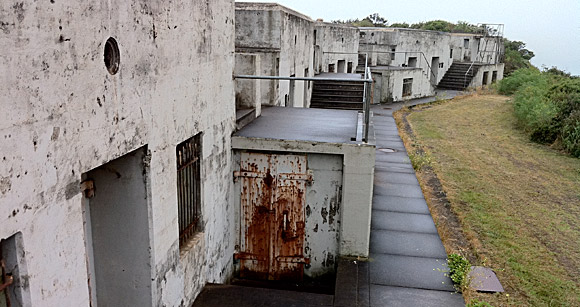
Battery Yates, Fort Baker, Sausalito, California.
Over a year ago, I posted some scraping metal sounds from the steel doors of Fort Baker’s Battery Yates, right at the Golden Gate of the San Francisco Bay. I recently unearthed some metal hits from that same session: They’re heavy, resonant, and the concrete rooms behind them certainly lent the sound some nice air in the low end. (Read the previous installment if you want to learn more about this location and how it was recorded.)
And, since today is Halloween, the original sounds are presented in both their original form and pitched down by an octave for extra heaviness and spookcreeptacularness.
Enjoy the clanky, boomy fun…and happy Halloween!
[soundcloud url=”http://api.soundcloud.com/tracks/65535342″ params=”auto_play=false&show_artwork=false&color=ee0000″ width=”100%” height=”166″ iframe=”true” /]
[MKH 50 microphone into Sound Devices 702]
Tags: creepy, field recording, industrial, metal, resonance, San Francisco, sound effects | No Comments »
Posted: October 13th, 2011 | Author: Nathan | Filed under: found sound objects, sound design
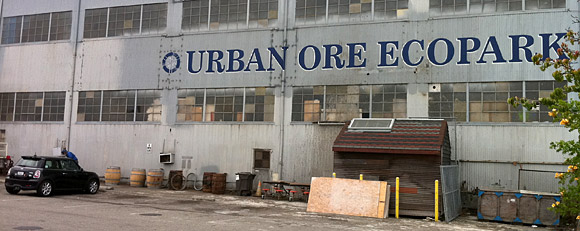
My mecca on a foggy morning: Urban Ore!
I went to the granddaddy of thrift stores recently, so much so that it’s more of a glorified junk store…but oh, what glorious junk. I’m talking about Urban Ore in Berkeley, California. Sometimes I’m self-conscious shopping for things by ear, picking up random things and just listening to them, but at Urban Ore – heck, Berkeley in general – I can ear-shop in peace.
I was in a metallic mood, so I filled a bag with things that squeak, resonate, creak, clank, and sproing. Based on the dronetastic results of striking wire shelving last year, I picked up a few thin-wire metal grills that had sonic promise, among other things that will surely find their way to this blog later this fall and winter.
For the grills, I decided to trot out my much-neglected piezo contact microphones. The resonant notes were so subtle that it seemed like the best way to capture the sound at a reasonable volume. I plucked them, struck them, and played them with a cello bow. The magic happened, though, when I realized one was easily played with a bow and the other was not, so I stuck the bowable one inside of the other, and played away, causing both of them to resonate when played appropriately.
The results were like ultra-low-fi bastardizations of stringed instruments played in horror movies, and I just loved the character. The rawness of hearing the actual hairs of the bow on the metal, in my opinion, lends to the eerie charm.
[soundcloud url=”http://api.soundcloud.com/tracks/25407627″ params=”show_comments=true&auto_play=false&color=ee0000″ width=”100%” height=”81″ ]
[Contact microphone into Sound Devices 702 recorder]
Tags: creepy, digital audio, eerie, found object, groaning, horror, metal, resonance, sound design, sound effects | No Comments »
Posted: May 12th, 2011 | Author: Nathan | Filed under: field recording, found sound objects, sound design
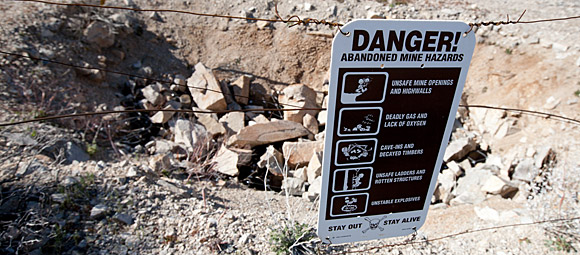
Eton Mine, Lucky Boy Trail, Joshua Tree National Park, California, USA.
[One in a series of posts from my spring 2011 trip to the southern California desert.]
Joshua Tree National Park is beautiful, but much of its history (prior to being designated a National Park) has scarred and pockmarked its landscape. In the Gold Rush, the Joshua Tree hinterlands held some of the most productive mines in California until well into the 1900’s. These mines were big, sprawling, and deep. To my knowledge, no Balrogs were released as a result. But that would explain a lot about Golden State politics.
We hiked on some lesser-traveled trails and found an acre of land with no fewer than five vertical holes in the ground: Mine shafts. They were all wired off and had metal grates over them. One in particular, the Eton Mine on the Lucky Boy trail, had warning signs on the wire fence surrounding it.
It was quite windy that day, and I just knew I had to get the creaking, squeaking sounds of this battered sign on the rusty wire. It took me a surprisingly long time to figure out how to protect my handheld recorder from the wind, but ultimately I decided to use my body as a shield and then stick it under my microfleece hoody. (I had the OEM fuzzy windscreen on it, which is one of the most useless strips of fabric I’ve ever seen, er, heard.) I just hoped that my body protected it from the 25+ mph wind gusts and that the fabric wouldn’t dampen the high frequencies too badly…and because of the sound, I had high-frequency content to burn.
With some judicious noise reduction in post – subtle, as always, gives the best result – it didn’t come out too shabby, considering the horrible recording conditions and super-no-budget wind blocking techniques!
[soundcloud url=”http://api.soundcloud.com/tracks/15163504″ params=”show_comments=true&auto_play=false&color=ee0000″ width=”100%” height=”81″ ]
[Sony PCM-D50 recorder, capsules at 120°]
Tags: creepy, desert, digital audio, eerie, field recording, found object, industrial, joshua tree, metal, resonance, sound design, sound effects, travel | 1 Comment »
Posted: March 4th, 2010 | Author: Nathan | Filed under: found sound objects, gear, sound design
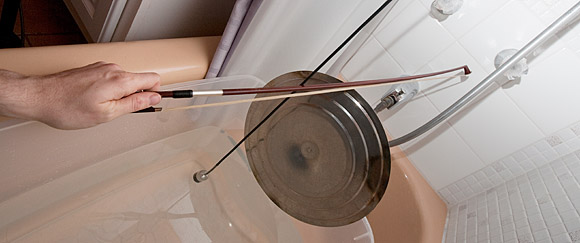
Horse hair, water, mic, and wok lid. Now we're cookin'!
My last post featured teensy finger cymbals being dipped in water while resonating, recorded with a submerged hydrophone. This time we go a bit bigger.
Bowed cymbals are one of the classic clichéd horror movie sounds…clichéd because they’re awesome! (coincidentally, just yesterday, Chuck Russom posted some great examples on his blog.) I recorded some a while back, borrowing some cymbals from a friend at work who keeps his drum kit at work. During that session I also realized that the wok lid from my kitchen made similar sounds, but with a different timbre: More groany, throaty, less musical, but with a quality I liked.
So, I played the wok lid with a violin bow as I moved it into and out of a tub of water, again with the trusty Aquarian H2a-XLR hydrophone tracking to a Sound Devices 702.  The H2a can be overly bright on some material, but for this stuff it was pretty good! (Next time I should record the above-water sound to a second channel with a small condenser mic for more mixing flexibility.)
The recording below is 100% unedited except for some slight compression and normalization.
[soundcloud url=”http://soundcloud.com/noisejockey/bowed-wok-lid-underwater” params=”show_comments=true&auto_play=false&color=dd0000″ width=”100%” height=”81″ ]
[Aquarian H2a-XLR hydrophone into Sound Devices 702 recorder]
Tags: audio equipment, bow, creepy, cymbal, found object, horror sounds, hydrophone, metal, sound design, sound effects | 7 Comments »



